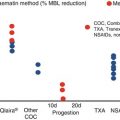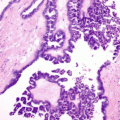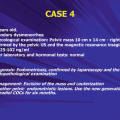Hormonal
Nonhormonal
COCs
The condom
Emergency contraception
The double dutch method (COCs and condom)
LARCs
Othersa
Injectable contraception
Sponge and diaphragm
IUDs
Abstinence
Implants
Withdrawal
Patches
Periodic sexual intercourse
Vaginal rings
5.2 Oral Contraceptives
Among the new generation COCs, those with estradiol or estradiol valerate together with the new progestagenic compounds are recommended [6].
If COCs are used properly, their failure rate is less than 1 %, while the typical failure rate is approximately 3 % in adults and 5–15 % in adolescents [6, 7]. On the other hand the noncontraceptive benefits of the new generation COCs should be emphasized to improve compliance during adolescence (Table 5.2) [8, 12].
Table 5.2
Noncontraceptive beneficial effects of 17 β-estradiol COCS
Ovarian cysts, premenstrual tension, ectopic pregnancies |
Endometrial, epithelial ovarian cancer and colorectal cancer |
Menstrual disorders: dysfunctional uterine bleeding, dysmenorrheal oligomenorrhea |
Endometriosis |
Pelvic inflammatory disease, dyspareunia, chronic pelvic pain |
Bone mass |
Polycystic ovarian syndrome: acne and hirsutism |
Lipid and carbohydrate profile, thyroid, hemostatic and inflammation makers, liver function |
Ovarian stimulation (pretreatment) |
The COCs side effects are the most commonly reported reasons why adolescents discontinue this method. COCs users discontinued their use because of sexually transmitted infections, the fear for breast and cervical cancer, as well as the venous thromboembolism.
Teens should be advised that COCs are only effective if taken regularly. Another contraceptive method should be followed if more than two consecutive pills are missed in any menstrual cycle. In any case, sexually active adolescents always should be advised to use condoms, even while taking COCs.
5.3 The Condom
The condom should be consistently used during adolescence preferably in combination with COCs (the double dutch method) as a method of providing complete protection against unwanted pregnancies and STDs. The condom is easily available and inexpensive, presents no side effects, and has an effectiveness of up to 88% [13].
5.4 Emergency Contraception
The emergency contraceptive methods are listed below [13–14]:
The combined “estrogen and progestin” emergency contraception (EC) kit. The kit contains four tablets of ethinyl estradiol and levonorgestrel.
The progestin-only product. Two tablets of levonorgestrel, to be taken 12 h apart.
A single dose of RU-486 – mifepristone. A progesterone blocker, which acts as an abortifacient given within 72 h of coitus with nearly of 100 % success rate.
A 19-nor-progestagenic derivative given within 5 days after coitus, acting as endometrial progestagenic modulator.
The situations that call for the use of EC are:
No contraception used
Condom breakage, slippage, or incorrect use
Three or more consecutive missed COCs
Progestogen-only pill (minipill) taken more than 3 h late
More than 2 weeks late for a progestogen-only contraceptive injection
Breakage, dislodgment, tearing, or early removal of a diaphragm or a cervical cap
Failed coitus interruptus
Failure of a spermicidal tablet
Expulsion of an intrauterine device
Stay updated, free articles. Join our Telegram channel

Full access? Get Clinical Tree






